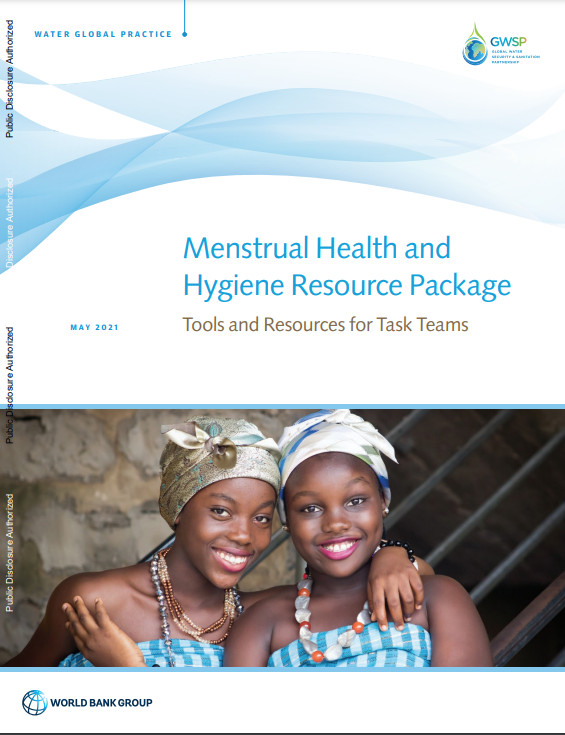Menstrual Health and Hygiene Resource Package: Tools and Resources for Task Teams
 |
guide May 2021 ; 69 pages
Aut. Mari Clark & Gaia Hatzfeldt
Ed. GWSP - Bonn
Downloadable format: PdF
Downloadable from the publisher
Abstract:
The purpose of this resource package is to assist World Bank task teams in ensuring that their projects are inclusive and responsive to the needs of women and girls.
The tools included in this package are practical and user-friendly and guide task teams on how to design and monitor effective, inclusive, and sustainable menstrual health and hygiene (MHH) initiatives as part of their water supply, sanitation, and hygiene (WASH) interventions. The tools are designed mainly for WASH interventions in schools and health care facilities (HCFs) but can also be adapted for projects in other public spaces, such as markets and public locations with WASH facilities. The tools draw from good practice examples in leading development agencies handbooks, guidelines, and case studies. The resource package is a living document that will be continually updated based on evolving needs and feedback.
The tools included in the resource package are as follows:
1. Fact Sheet on Menstrual Health and Hygiene defines the term menstrual hygiene management (MHM) and the broader concept of menstrual health and hygiene and explains why it matters for education, health, and economic development outcomes, each of which affects the well-being, opportunities, and choices for girls and women. Actions needed for an enabling environment for MHH are noted.
2. Checklists
i. Checklist for Assessing Menstrual Health and Hygiene Gaps and Needs provides key questions to ask to assess the current status of MHH in the project area, particularly focusing on policies, stakeholders, school programs, and health care facilities. It also provides questions to understand the sociocultural beliefs and practices and the underlying gender stereotypes and gaps that affect MHH.
ii. Checklist on Design Features for Inclusive Sanitation Facilities briefly highlights key questions to ask when designing female-friendly water supply, sanitation, and hygiene infrastructure in public places, schools, and HCFs, including early engagement with users on their needs and priorities.
iii.Checklist for Behavior Change Communication on Menstrual Health and Hygiene defines social and behavior change communication (SBCC) and provides key questions to ask in developing SBCC activities and campaigns to promote MHH.
iv. Checklist for Working with Social Enterprises to Improve Access to Menstrual Products provides key questions to ask when partnering with social enterprises in efforts to improve access to menstrual products for women and girls.
v. Checklist for Menstrual Waste Management lists key questions to ask when assessing menstrual waste disposal and collection mechanisms, understand sector governance and institutional capacity, and ensure infrastructure functionality and staff training.
3. Tool on Policies and Regulations includes a list of entry points on how to affect change at the policy level to ensure that menstrual products are affordable, accessible, and safe. It discusses some of the World Bank instruments available to teams to affect change at the policy level.
4. Examples of Construction Plans for Female-Friendly Sanitation Facilities provides examples of floor plans and construction views of WASH facilities that meet MHH requirements and a plan for a toilet 2 Menstrual Health and Hygiene Resource Package connected to a waste incinerator and an incineration system plan. This tool also lists resources for additional plans and designs. Contents:
Tool 1: Fact Sheet on Menstrual Health and Hygiene 3
What Is MHM and MHH? 3
Why Does MHH Matter? 3
Attention to MHH Matters on Many Levels 3
Educational Impacts of Inadequate MHH 5
Sexual and Reproductive Health Impacts of Inadequate MHH 6
Economic Impacts of Inadequate MHH 7
Environmental Impacts of Inadequate MHH 7
Way Forward 8
Tool 2: Checklists 9
I. Checklist for Assessing Menstrual Health and Hygiene Gaps and Needs 9
II. Checklist on Design Features for Inclusive Sanitation Facilities 12
III. Checklist for Social and Behavior Change Communication on Menstrual Health and Hygiene 16
IV. Checklist for Working with Social Enterprises to Improve Access to Menstrual Products 19
V. Checklist for Menstrual Waste Management 23
Tool 3: Tackling Affordability, Accessibility, and Safety of Menstrual Products through
Policies and Regulations 25
Context of “Period Poverty” 25
Policy Interventions 25
World Bank Group Instruments for Policy Reforms 28
Tool 4: Examples of Construction Plans for Female-Friendly Sanitation Facilities 29
Tool 5: Measuring Results on Menstrual Health and Hygiene 33
Objectives and Limitations of the Indicator Chart 33
Tool 6: Generic Terms of Reference: Menstrual Health and Hygiene Consultancy 39
Background: Why Menstrual Health and Hygiene Matters to Water Projects 40
Objectives of the MHH assessment 41
Scope of Work 41
Deliverables 48
Contract Administration 48
Tool 7: Annotated List of Menstrual Health and Hygiene Resources 51
References 55
Target Audience:
Keyword: |
Publisher/Broadcaster: |
|
GWSP
-
Global Water System Project International Project Office - Bonn - Germany |
If there is a broken link, we will be pleased to receive a message: communication@pseau.org